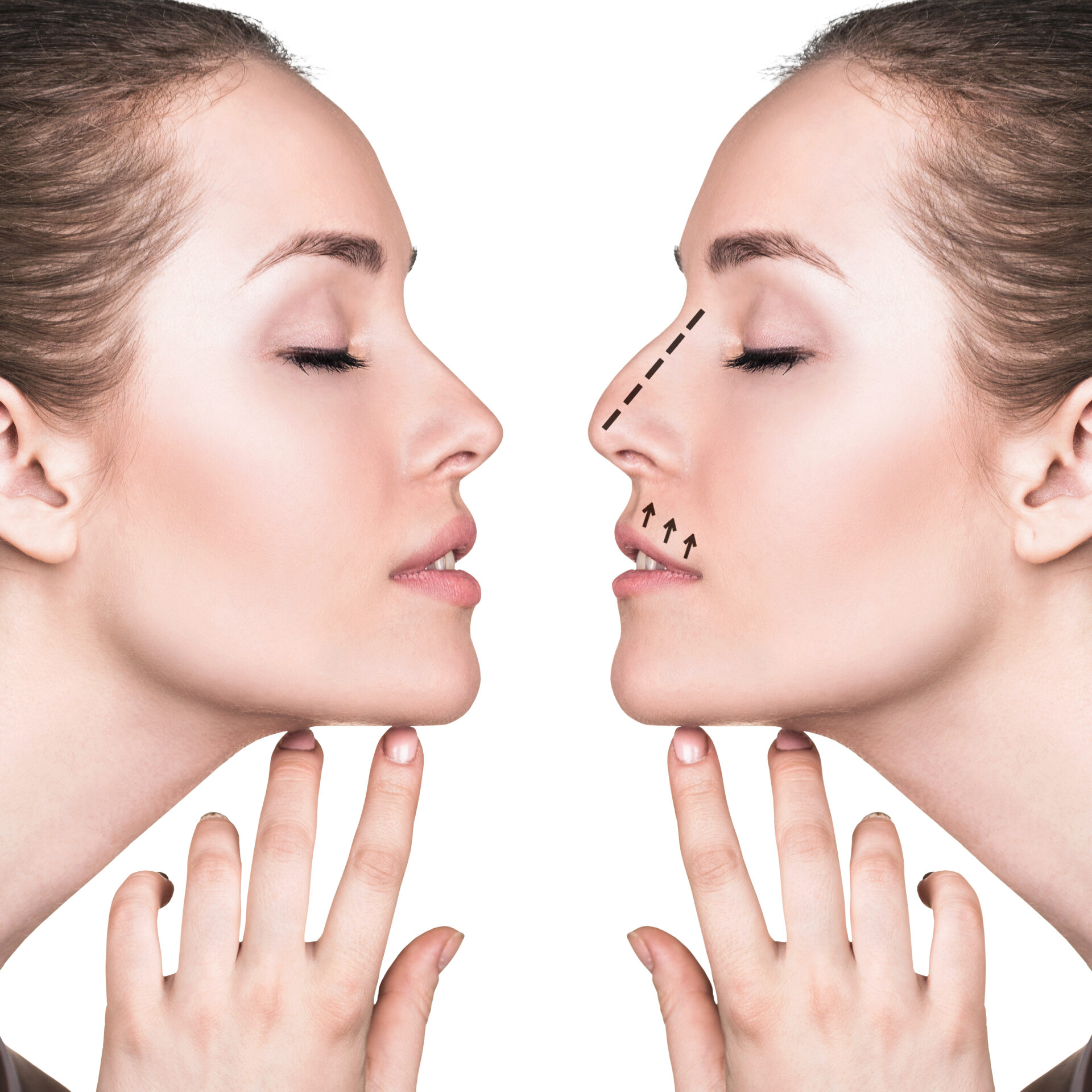Rhinoplasty
Rhinoplasty, also known as a "nose job," is a surgical procedure aimed at altering the nose's shape, size, or overall appearance. It can be performed for both cosmetic and functional reasons.
Common goals of rhinoplasty include:
- Reshaping the nose to improve its aesthetic appearance.
- Correcting asymmetry or disproportionality of the nose.
- Refining the nasal tip.
- Straightening a crooked nose.
- Modifying the bridge of the nose.
- Adjust the size of the nostrils.
- Enhancing or reducing the overall size of the nose.
- Correcting breathing difficulties caused by structural nasal abnormalities.
Rhinoplasty is a highly customizable procedure tailored to the individual's unique facial features and desired outcome. It can involve various techniques, such as modifying bone, cartilage, and soft tissue to achieve the desired results.
The three most frequently asked questions about rhinoplasty are:
- What is the recovery process like after rhinoplasty?
The recovery process can vary from person to person, but there are some common aspects to consider. After rhinoplasty, you can expect swelling and bruising around the nose and eyes, which typically peak in the first few days and gradually subside over the following weeks. Nasal congestion, mild discomfort, and a sensation of stuffiness are also common. Most people can return to work or school within one to two weeks, although strenuous activities should be avoided for several weeks. Complete resolution of swelling and final results can take several months to a year.
- Are the results of rhinoplasty permanent?
Rhinoplasty can provide long-lasting results, but it's important to note that the nose will continue to age naturally along with the rest of the face. While the surgical changes made during rhinoplasty are generally permanent, factors such as ageing, genetics, and lifestyle choices can still affect the appearance of the nose over time. It's essential to communicate your goals and expectations with your surgeon to ensure realistic and satisfactory outcomes.
- Will rhinoplasty be painful?
Pain levels can vary among individuals, but most people report mild to moderate discomfort following rhinoplasty. Pain medication prescribed by your surgeon can help manage any discomfort during the initial recovery period. The first few days after surgery may involve some discomfort, congestion, and a feeling of pressure. As the healing progresses, these symptoms typically improve. It's crucial to follow your surgeon's post-operative instructions, which may include pain management strategies to ensure a smooth and comfortable recovery.
Remember, if you're considering rhinoplasty or have specific concerns, it's best to consult with a qualified plastic surgeon who can provide personalized information based on your unique situation.
Septoplasty
Septoplasty is a surgical procedure performed to correct a deviated septum. The septum is the wall of cartilage and bone that divides the nasal cavity into two halves. When the septum is crooked or deviated, it can obstruct the airflow through the nose, leading to breathing difficulties and other nasal problems. Septoplasty aims to straighten the deviated septum, improving nasal breathing and overall nasal function.
During septoplasty, the surgeon makes an incision within the nose and lifts the mucous membrane covering the septum. They then carefully reposition or remove the deviated portion of the septum to create a straighter nasal passage. Afterwards, the mucous membrane is repositioned, and the incisions are closed.
The three most frequently asked questions about septoplasty are:
- How long does it take to recover from septoplasty?
Recovery time can vary, but most people can expect to resume their normal activities within one to two weeks after septoplasty. Initially, you may experience swelling, congestion, and mild discomfort. Your surgeon may recommend pain medication and nasal sprays to manage these symptoms. It's important to follow your surgeon's post-operative instructions, which may include avoiding strenuous activities, keeping the head elevated, and using saline rinses to promote healing. Full recovery and the resolution of nasal congestion may take several weeks to a few months.
- Will septoplasty change the appearance of my nose?
The primary goal of septoplasty is to improve nasal breathing and correct structural issues related to the septum. While septoplasty focuses on the internal structures of the nose, there can be some subtle changes in the external appearance. For example, if the septum was causing the nose to appear crooked or asymmetrical, straightening the septum during septoplasty may result in a more balanced and aesthetically pleasing appearance. However, septoplasty alone is not intended for cosmetic changes. If you're seeking cosmetic alterations to the nose, you may want to discuss rhinoplasty or septorhinoplasty with your surgeon.
- Is septoplasty a painful procedure?
Septoplasty is generally well-tolerated, and discomfort levels can vary among individuals. Most people report mild to moderate pain or discomfort after the surgery, which can be managed with prescribed pain medications. Some swelling and nasal congestion are common in the first few days following surgery. It's important to follow your surgeon's instructions regarding pain management, nasal care, and activity restrictions to ensure a smooth recovery.
As with any surgical procedure, it's advisable to consult with a qualified otolaryngologist or ENT surgeon who can provide detailed information and address any specific concerns you may have about septoplasty. They can assess your nasal condition, explain the procedure in detail, and guide you through the recovery process.
Are the two procedures connected and done together?
Rhinoplasty and septoplasty can be performed together if the patient desires both cosmetic enhancements and functional improvements. In such cases, it is referred to as a septorhinoplasty. Combining the procedures allows for the correction of the nose's aesthetic and functional aspects. For example, a patient seeking to improve the appearance of their nose while also addressing breathing difficulties due to a deviated septum might opt for a septorhinoplasty.
It's important to consult with a qualified plastic surgeon or an otolaryngologist (ear, nose, and throat specialist) to determine the best course of action based on your concerns and goals. They can assess your nasal structure, discuss your expectations, and recommend the most appropriate surgical approach.
